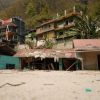Friday, April 26, 2024
News and Views from the Global South
RIGHTS-ARGENTINA: Tortured Labour, Stolen Newborns
Marcela Valente
- “Torture with the electric prod when she was close to term induced accelerated labour,” says the report “Maternidades Clandestinas” (Motherhood in Clandestine Prisons), which tells the stories of dozens of women illegally imprisoned during Argentina’s 1976-1983 dictatorship.
The study by the non-governmental Grandmothers of Plaza de Mayo Association was published on the Internet this year, and is updated whenever new evidence arises or young people born to political prisoners in captivity are reunited with their families, three decades later.
Since they formed the association to look for their grandchildren who disappeared during the dictatorship, the Grandmothers have been able to restore the original identities of 88 young people. But they are not satisfied, as another 400 were kidnapped together with their parents, or were born in torture camps and given secretly in illegal adoptions.
Vanina Wiman, a member of the research team at the Gradmothers branch in La Plata, the capital of the province of Buenos Aires, told IPS that “for the moment” work is focused on eight illegal detention centres that operated in the province, but they know that there are “many more cases,” and hope to investigate them all.
Their report documents the histories of 77 pregnant women in the eight prison camps. Out of these, 43 are still disappeared, 16 were released and 18 are unidentified. It is a particularly harrowing reconstruction, as the women gave birth in the worst conditions imaginable.
“The aim is to reconstruct individual histories, build up a description of the clandestine ‘maternity wards,’ and obtain a complete list of the detainees who were at each prison and the personnel who participated in the deliveries, to help search for the grandchildren,” said Wiman.
After a general introduction, the report is divided into eight chapters describing conditions at the eight clandestine detention centres. The histories of women abducted while pregnant and who gave birth or miscarried in prison are examined in detail.
“Treatment of pregnant women was no different from that of the other captives,” says the report on the La Cacha centre. “In general they were beaten and subjected to physical and psychological torture.” According to witnesses, torture undergone by Lucía Marroco resulted in a miscarriage.
The researchers say that 91 detainees, including six pregnant women, were held at the Brigada de Investigaciones premises in La Plata. Liliana Galarza, still disappeared, gave birth there to a baby girl who was baptised by Christian von Wernich, the Catholic priest convicted of genocide on Oct. 9 for his activities as a police chaplain.
Meanwhile, Police Station No. 5 in La Plata housed 180 political prisoners, among them 10 pregnant women. When they went into labour the women were taken to a nearby hospital, but one of them, Inés Ortega, had to give birth “on a dirty kitchen table,” according to the report.
“Penned in, her wrists bound and in front of all the prison guards, Inés gave birth to a son whom she named Leonardo,” the report says. Five days after the birth, the baby was taken from her. Her son found out who he really was at the age of 28, thanks to the work of the Grandmothers of Plaza de Mayo.
In La Cacha there were 158 detainees, both male and female, including 14 pregnant women. The state Olmos prison, which held another 10 expectant mothers, was located on the same city block and had a hospital. The report points to the large number of medical personnel who attended these women.
Paediatricians, anaesthetists, midwives, obstetricians and nurses; they all knew that these women were kidnap victims, and many of them were accomplices in the theft of the newborn babies. But some midwives and nurses were themselves disappeared by the dictatorship for telling relatives of the women what had happened to their loved ones.
“When childbirth was imminent, the pregnant woman was taken to a labour room on the first floor which was used as a sickbay,” says the report, describing the Pozo de Banfield, another detention centre where 182 prisoners were held illegally for periods of time, and where 16 births took place in captivity.
“Handcuffed to a stretcher and without even the most minimal hygiene, the women gave birth amid the insults of police doctor Jorge Bergés and other staff. Immediately after giving birth, the women were forced to clean the sickbay,” the report says.
Another woman held in the Banfield centre was Laura Carlotto, daughter of the present head of the Grandmothers of Plaza de Mayo Association. Kidnapped in 1977 when she was two months pregnant, she gave birth to a boy she named Guido shortly before being murdered by her captors.
Estela Barnes de Carlotto’s grandson is still missing.
The Grandmothers of Plaza de Mayo Association was founded in October 1977 by the mothers of young adults who had disappeared, who vowed to find the children of their sons and daughters. A little earlier, on Apr. 30, 1977, the Mothers of Plaza de Mayo Association had been formed to search for their missing sons and daughters.
Plaza de Mayo is a square in front of the Argentine government house in Buenos Aires where the mothers would hold a protest every Thursday, walking steadfastly round the square, in spite of the climate of brutal intimidation.
These and other human rights organisations have not rested in their pursuit of lawful punishment for the crimes committed during the dictatorship, which left 30,000 people disappeared after illegal detention, according to their estimates.
At first the Grandmothers were only a dozen women, who in desperation delivered a letter to then U.S. Secretary of State Cyrus Vance (1977-1980), serving under President Jimmy Carter (1977-1981), during Vance’s visit to Argentina in 1977.
They have created a National Genetic Data Bank to match people with their relatives and restore their identity, and have devised a large number of projects for education on human rights and raising awareness on the right to identity.
In the early 1990s, it appeared likely that the amnesty laws and presidential pardons would allow perpetrators of atrocities during the dictatorship to escape prosecution for good.
But the Grandmothers’ lawyers, among others, were able to reopen prosecutions of former military officers with evidence that the children of political prisoners had been systematically stolen under the military regime.
Now only about twenty Grandmothers are still active. Many have died, or are too old to continue their search. But their work lives on. In July 2007, Belén Altamiranda, born in 1977 in the Campo de Mayo barracks hospital on the outskirts of Buenos Aires, was found.
Her mother, Rosa Luján Taranto, was kidnapped when carrying Belén, and held in the El Vesubio detention centre, together with 15 other pregnant women. When she went into labour she was taken away, and according to witnesses she came back and told them she had had a baby girl. After that, Luján was never seen again.
Her story is known because Elena Alfaro, another detainee at El Vesubio, survived and was able to tell the tale. Alfaro, too, “was tortured with electric prods, beaten, whipped and burned with cigarettes, in spite of her obviously pregnant condition.”
“They constantly told her that they would kill her baby,” the report says.
While she was carrying her child, Alfaro was also raped by the head of the clandestine centre, Pedro Durán Sáenz. In spite of it all, she gave birth to a son, Luis Felipe, in captivity. Later they were both freed and went into exile in France.

 Print
Print



